San Diego, a coastal paradise known for its sun and surf, offers an exceptional stargazing experience for locals and visitors. Its diverse landscapes, from mountains to beaches, provide a range of locations to marvel at the cosmic wonders above.
As an amateur astronomer or simply someone who appreciates the beauty of the night sky, you’ll find that San Diego’s star-studded offerings are a must-explore adventure.
In addition to its dark skies, San Diego is home to numerous events, organizations, and observatories dedicated to the appreciation of astronomy. Combining your passion for stargazing with the city’s unique opportunities creates a memorable experience you can treasure for a lifetime.
Pack your telescope, a blanket, and your sense of wonder, and embark on a celestial journey under the captivating night skies of San Diego.
In a Nutshell:
- San Diego offers diverse stargazing locations for various skill levels, from beginners to professionals
- The city hosts numerous events and organizations dedicated to the appreciation of the night sky
- Optimal stargazing periods in San Diego vary, allowing for unique viewing experiences throughout the year
In this article, you get to
Explore Diverse Stargazing Locations: Discover a variety of stargazing spots across San Diego, from deserts to beaches, catering to different levels of expertise.
Experience Dark Skies: Immerse yourself in the darkness of San Diego’s prime stargazing locations, away from city lights, for optimal celestial viewing.
Learn from Experts: Gain insights from expert tips and practical advice to enhance your stargazing journey and make the most of your cosmic exploration.
Uncover Hidden Gems: Find lesser-known spots like Black’s Beach and Little Blair Valley, where you can indulge in stargazing without the interference of urban light pollution.
Engage with Astronomy Organizations: Connect with local astronomy groups, such as the San Diego Astronomy Association (SDAA), to participate in events, workshops, and star parties.
Attend Stargazing Events: Attend unique events like Julian Starfest and “Stars in the Park” at Balboa Park, offering opportunities to meet fellow stargazers and experts.
Visit Renowned Observatories: Explore renowned observatories like Palomar Observatory and Mount Laguna Observatory, providing access to powerful telescopes and guided experiences.
Appreciate Meteor Showers: Learn the best times to witness meteor showers in San Diego, with tips on selecting optimal viewing periods.
Embrace Nature and Tranquility: Escape into the serene settings of parks and natural reserves, from Balboa Park to Cleveland National Forest, for tranquil stargazing experiences.
Equip Yourself for Success: Understand essential stargazing equipment, including telescopes, star charts, and red flashlights, to elevate your cosmic adventure.
By the end of this article, you’ll be equipped with the knowledge and inspiration to embark on a captivating journey of stargazing in San Diego, discovering the best spots, engaging with astronomy organizations, and making the most of celestial events.
Let’s dive right in.
Recommended For You
Best San Diego Star Gazing Locations
My list of the 23 best locations for stargazing in San Diego is meant to inspire you to explore the night sky. After the list, I provide tips and helpful resources for stargazing in San Diego, so be sure to check those out.
23 Best San Diego Stargazing Spots
- Anza-Borrego Desert State Park
- Balboa Park – Fleet Science Center
- Black’s Beach
- Borrego Springs
- Cabrillo National Monument
- Centennial Park
- Cleveland National Forest
- Cowles Mountain
- Hilltop Park
- Jacumba Hot Springs
- Julian
- Lake Cuyamaca
- Little Blair Valley
- Mission Trails Regional Park
- Mount Laguna
- Mt. Helix Park
- Mt. Soledad National Veterans Memorial
- Ocean Beach
- Palomar Observatory
- Sunset Cliffs Natural Park
- Tierra del Sol
- Torrey Pines State Natural Reserve
- Windansea Beach
Anza-Borrego Desert State Park
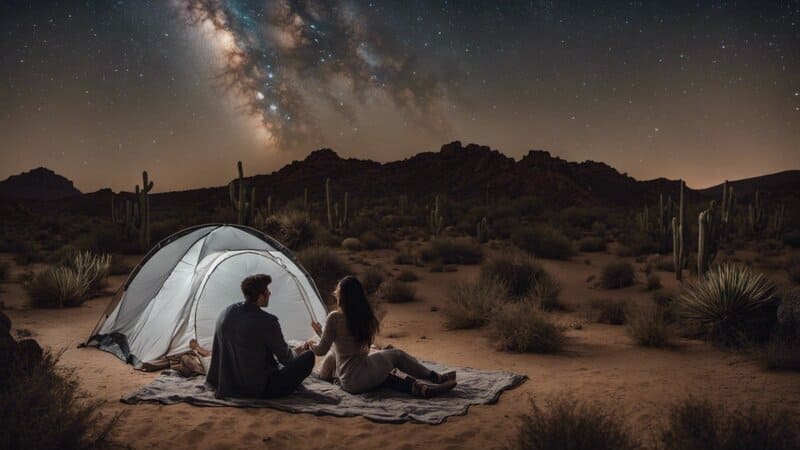
Located just two hours from San Diego, Anza-Borrego Desert State Park offers a mesmerizing stargazing experience. Nestled within its vast desert landscapes, this park provides an excellent escape from the bustling city lights. During the daytime, the park reveals its unique beauty with stunning desert flora and the famed California desert wildflower blooms in spring. The rugged terrain, sculpted by time, adds to the park’s allure.
At night, Anza-Borrego’s dark skies unveil a celestial spectacle. Far away from urban light pollution, this location offers exceptional stargazing conditions. The park’s elevation and remote setting enhance visibility, allowing you to witness a myriad of stars, planets, and constellations. The Milky Way arches overhead, creating a breathtaking celestial panorama.
Keep an eye out for any stargazing events organized by local astronomy groups, offering guided tours of the night sky and insights from passionate experts. Anza-Borrego also provides prime meteor shower viewing opportunities to witness shooting stars streaking across the desert sky.
FREE STARGAZING CHECKLIST
My 5-page Stargazing Checklist will enhance your astronomical observations.
Follow this free checklist to navigate the night sky with confidence, clarity, and a sense of preparedness for a rewarding stargazing experience.

Balboa Park
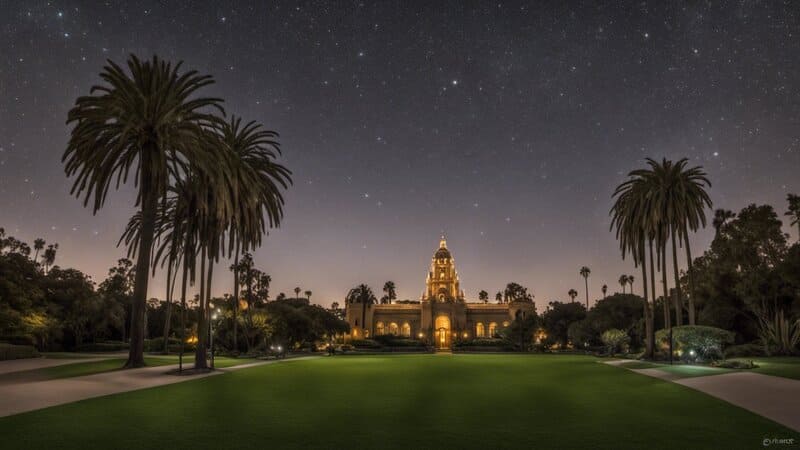
Situated close to downtown San Diego, Balboa Park offers a unique blend of cultural attractions and stargazing opportunities. Explore the park’s lush gardens, intricate architecture, and world-class museums during the daytime. The iconic Balboa Park even hosts the Fleet Science Center, a scientific discovery and exploration hub.
As the sun sets, Balboa Park transforms into a stargazing haven. The Fleet Science Center frequently organizes stargazing events, making it an excellent location for amateur astronomers and families. These events often include telescope observations, celestial presentations, and interactive sessions. Engage with local astronomers, ask questions, and deepen your understanding of the cosmos.
The park’s central location allows convenient access, making it an ideal spot for a spontaneous stargazing adventure. With the juxtaposition of city lights and celestial wonders, Balboa Park provides an enchanting urban stargazing experience that bridges the gap between science and art.
Black’s Beach
Nestled near La Jolla, Black’s Beach offers a unique and secluded setting for stargazing. By day, this pristine beach is known for its rugged beauty and striking cliffs that line the shoreline. While the beach is renowned for its naturist reputation, it also boasts impressive geological formations and breathtaking views of the Pacific Ocean.
As daylight gives way to night, Black’s Beach becomes an enticing destination for stargazers seeking solitude and unobstructed views. The beach’s remote location minimizes the impact of urban light pollution, allowing celestial objects to shine brightly in the dark sky.
Black’s Beach offers an ideal combination of tranquility and natural beauty, making it an optimal spot for intimate stargazing experiences. Lie back on the sand, away from the city lights, and watch as stars, planets, and constellations emerge to create a celestial spectacle above the waves.
Borrego Springs
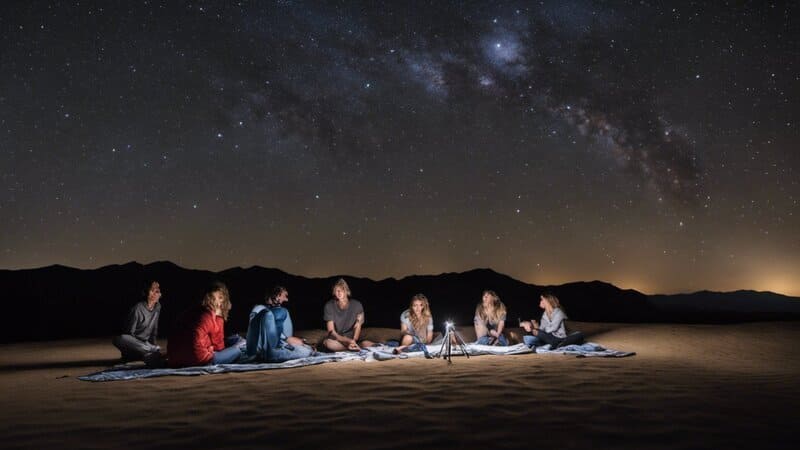
Venture on a two-hour drive from San Diego to discover the enchanting stargazing haven of Borrego Springs. This designated Dark Sky Community boasts a unique charm that extends from daytime exploration to celestial wonders after dark. During the day, Borrego Springs reveals its artistic side with an outdoor gallery of metal sculptures that dot the landscape. As the sun sets, the sculptures transform under the starlit sky, offering an intriguing fusion of art and astronomy.
Borrego Springs provides an exceptional stargazing experience in the barren desert landscape. The absence of intrusive city lights creates an immersive celestial canvas. Dim streetlights ensure minimal light pollution, allowing you to witness the brilliance of stars, planets, and distant galaxies. The serene desert surroundings amplify the cosmic experience, making it a favorite among both amateur and professional stargazers.
Apart from its natural allure, Borrego Springs also hosts stargazing events that elevate your astronomical adventure. Local astronomy clubs often organize public gatherings, offering telescope observations, celestial talks, and opportunities to connect with fellow enthusiasts.
Cabrillo National Monument
Perched within the Point Loma Peninsula, Cabrillo National Monument offers a unique vantage point for both daytime and nighttime exploration. By day, immerse yourself in the monument’s rich history and panoramic views of the San Diego skyline, harbor, and coastline. The Old Point Loma Lighthouse stands as a historic landmark, providing insight into maritime history and serving as a cultural highlight.
As darkness descends, Cabrillo National Monument unveils its celestial allure. With the Pacific Ocean stretching beyond the horizon, you can observe stars glimmering above both land and water. The monument’s elevated position minimizes light pollution, granting you unobstructed views of the night sky.
Consider bringing binoculars or a telescope to enhance your observations of planets and constellations. The combination of history, oceanic vistas, and celestial beauty makes Cabrillo National Monument a captivating destination for daytime and nighttime adventurers alike.
Centennial Park

Situated on picturesque Coronado Island, Centennial Park serves as a serene escape with captivating offerings during the day and night. During daylight hours, revel in the park’s lush greenery, waterfront views, and stunning sculptures that celebrate the island’s history. The iconic San Diego skyline and harbor create a picturesque backdrop for daytime exploration.
As the sun sets, Centennial Park transforms into a stargazer’s paradise. Its unobstructed views of the night sky allow for unhindered celestial observations. The absence of city lights enhances visibility, revealing stars, planets, and constellations with clarity. The juxtaposition of urban beauty and cosmic splendor creates a unique stargazing experience.
Cleveland National Forest
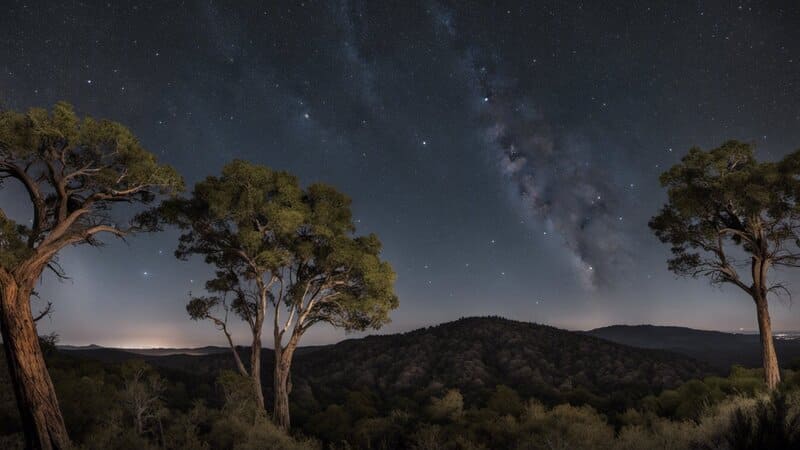
Embark on an hour’s drive from San Diego to reach the serene embrace of Cleveland National Forest, a daytime haven that seamlessly transitions into a stargazing paradise by night. During the day, this forest beckons with its diverse landscapes, encompassing towering trees, rugged terrain, and tranquil streams. Hiking trails wind through the wilderness, offering opportunities for nature enthusiasts to explore the beauty of Southern California’s backcountry.
As darkness envelopes the forest, Cleveland National Forest transforms into an idyllic stargazing escape. Its remote location and elevation create an environment free from urban light pollution, providing a canvas for the night sky’s brilliance. Gaze upon constellations, planets, and celestial wonders that reveal themselves against the backdrop of the forest’s natural beauty.
Cowles Mountain
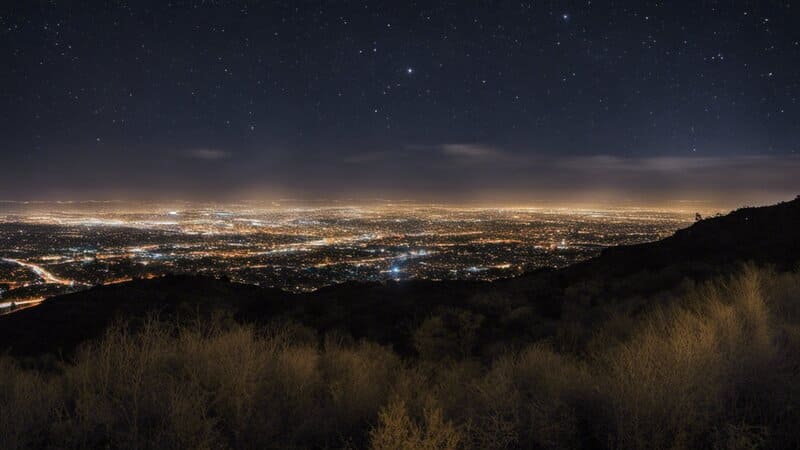
As the highest point in San Diego, Cowles Mountain stands as a beacon for both daytime hiking enthusiasts and nighttime stargazers. By day, venture on a hike to the summit and be rewarded with panoramic views of the city, surrounding mountains, and the Pacific Ocean. The trail’s accessibility and well-defined paths make it a popular destination for outdoor enthusiasts.
As twilight paints the sky, Cowles Mountain reveals its celestial splendor. The summit’s elevation reduces the impact of city lights, creating an optimal environment for stargazing. Away from urban glare, you’ll be greeted by stars that twinkle with clarity. Whether you’re armed with a telescope or simply gazing with the naked eye, Cowles Mountain offers a memorable cosmic experience.
Hilltop Park
Nestled in Chula Vista, Hilltop Park offers an easily accessible vantage point for both daytime exploration and nighttime stargazing. During the day, bask in the tranquility of this hillside oasis, surrounded by greenery and open skies. The park’s elevated position provides sweeping views of the surrounding landscapes, making it a perfect spot for picnics and relaxation.
As the sun sets, Hilltop Park transitions into a stargazer’s dream. Its elevated location reduces the impact of light pollution, offering a clear canvas for celestial observation. Unveil the beauty of the night sky as stars, planets, and constellations come into view. Consider bringing a pair of binoculars or a telescope to enhance your experience.
Jacumba Hot Springs
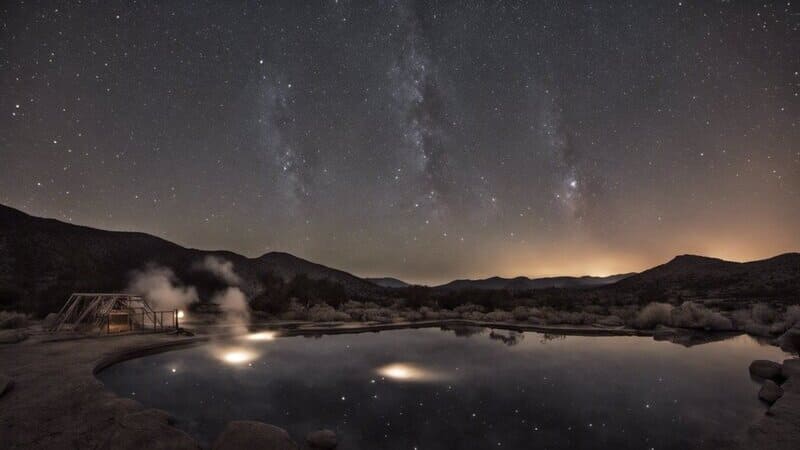
Nestled near the Mexican border, Jacumba Hot Springs offers more than just its therapeutic waters. By day, this unique location invites you to soak in its natural hot springs, providing relaxation and rejuvenation in a desert oasis. The surrounding landscape showcases desert flora and rugged terrain, adding to the area’s allure.
As the sun dips below the horizon, Jacumba Hot Springs transforms into an unforgettable stargazing destination. The desert’s remote location minimizes light pollution, allowing stars to twinkle with unmatched brilliance. Dark skies and minimal light interference create an optimal environment for celestial observations.
This border town’s secluded nature contributes to an extraordinary stargazing adventure. Consider bringing a telescope or binoculars to enhance your experience of the night sky. As you gaze upon stars, planets, and celestial wonders, you’ll be captivated by the vastness and beauty of the cosmos. Jacumba Hot Springs offers a unique blend of relaxation and astronomical exploration, making it a hidden gem for both daytime and nighttime adventurers.
Julian

Embark on an hour’s drive from San Diego to discover the charming mountain town of Julian, where stargazing complements its historic charm. During the day, explore Julian’s quaint streets, historic buildings, and boutique shops. The town is known for its apple orchards and cozy atmosphere, making it a delightful destination for daytime exploration.
Read my in-depth article about Stargazing Julian.
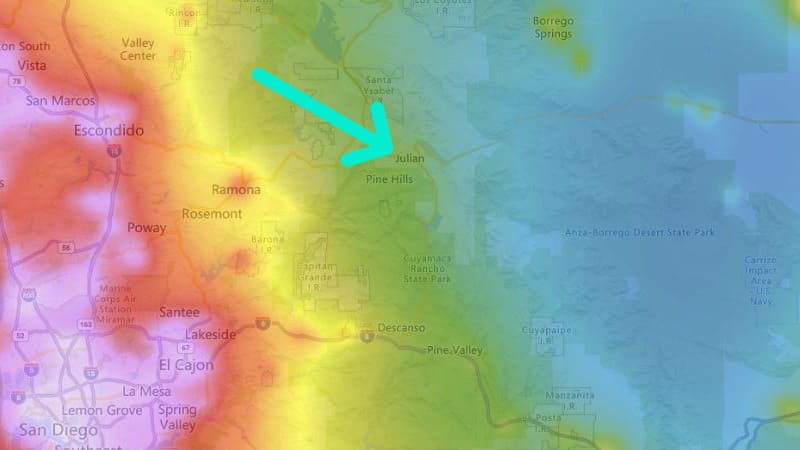
As the sun sets, Julian’s allure extends beyond its historic charm. The town’s elevation and relatively low light pollution create a captivating stargazing environment. Dark skies unveil the brilliance of stars, planets, and distant galaxies, allowing you to immerse yourself in the celestial wonders above.
In addition to its natural beauty, Julian hosts stargazing events that foster a sense of community among astronomy enthusiasts. Join others for guided telescope observations, discussions about astronomical phenomena, and the opportunity to connect with fellow stargazers. Julian’s unique blend of history, charm, and celestial splendor makes it an ideal destination for a day of exploration followed by a night of stargazing.
Lake Cuyamaca

Located near Julian, Lake Cuyamaca offers a captivating dual experience for nature lovers and stargazers alike. By day, indulge in outdoor activities such as fishing, hiking, and picnicking by the lake’s serene shores. Surrounding mountains and lush landscapes add to the area’s scenic beauty.
As twilight falls, Lake Cuyamaca takes on a new identity as a stargazing haven. The absence of city lights enhances visibility, unveiling stars, planets, and constellations against the backdrop of the lake’s reflection. The tranquil setting provides a serene ambiance for cosmic exploration.
Little Blair Valley

Nestled on the western edge of Anza-Borrego Desert State Park, Little Blair Valley is a stargazing gem waiting to be discovered. By day, explore the expansive desert landscapes and ancient rock formations that characterize this unique valley. The stark beauty of the surroundings sets the stage for a captivating daytime adventure.
As daylight fades, Little Blair Valley unveils its true splendor as a prime stargazing location. Its remote location within the state park ensures minimal light pollution, allowing the night sky to shine with unmatched brilliance. The valley’s expansive openness provides an unobstructed view of stars, planets, and celestial phenomena.
Mission Trails Regional Park
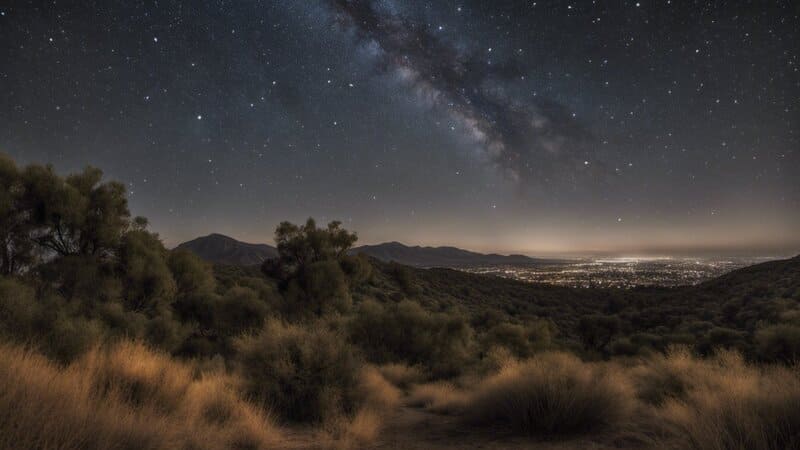
A stone’s throw from downtown San Diego, Mission Trails Regional Park offers both urban convenience and natural serenity during the day, making it a perfect destination for both nature lovers and stargazing enthusiasts. By day, explore the park’s extensive network of hiking trails, enjoy birdwatching, and soak in the beauty of native plants and wildlife.
As the sun sets, Mission Trails Regional Park transforms into a stargazer’s paradise. The park’s proximity to the city doesn’t diminish its stargazing potential, thanks to carefully managed lighting to minimize light pollution. Enjoy a celestial escape as stars emerge in the night sky, creating an enchanting backdrop to the park’s scenic beauty.
Mount Laguna
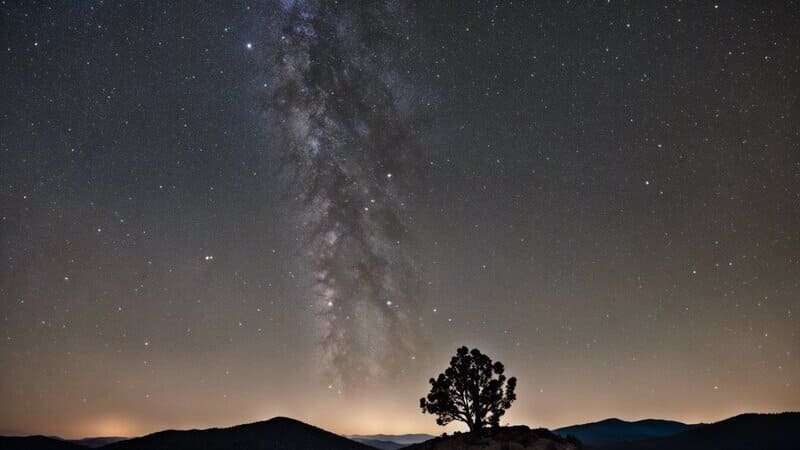
Escape the city lights and ascend to Mount Laguna for an elevated stargazing experience. By day, revel in the stunning views from an altitude of over 6,000 feet. Dense forests, alpine meadows, and crisp mountain air set the stage for outdoor activities such as hiking and wildlife watching.
As twilight descends, Mount Laguna unveils its celestial allure. The elevation significantly reduces light pollution, creating optimal conditions for stargazing. With the Milky Way arching overhead and stars dotting the sky, the mountain’s clear nights offer an incredible canvas for cosmic exploration.
Consider bringing a telescope to observe distant celestial objects in greater detail. Mount Laguna’s unique combination of elevated location and dark skies has made it a favorite spot for stargazers and even astronomy clubs hosting public events. Whether you’re a solo traveler or a family seeking a night under the stars, Mount Laguna’s natural beauty and cosmic wonders await your discovery.
Mt. Helix Park
Nestled in San Diego’s East County, Mt. Helix Park offers a blend of urban charm and stargazing excellence. By day, explore the park’s amphitheater and the iconic Mt. Helix cross, which provide sweeping views of the city and coastline. The park’s elevated location offers a serene escape from the urban hustle.
As the sun sets, Mt. Helix Park transforms into a stargazer’s paradise. The elevated position reduces light pollution, enhancing the visibility of celestial wonders. Enjoy unobstructed views of stars, planets, and cosmic phenomena against the backdrop of the city lights below.
Mt. Soledad National Veterans Memorial

Located in the heart of La Jolla, the Mt. Soledad National Veterans Memorial offers a one-of-a-kind stargazing experience that combines celestial wonders with panoramic views of the city and coastline. During the day, explore the memorial’s historical significance and pay homage to veterans while enjoying the well-maintained grounds and stunning vistas.
As the sun sets, Mt. Soledad Memorial becomes an exceptional spot for stargazing. Its elevated position provides a sweeping vantage point over the city, reducing the impact of light pollution. This unique combination of urban accessibility and stargazing excellence makes it an attractive destination for both locals and visitors.
Ocean Beach
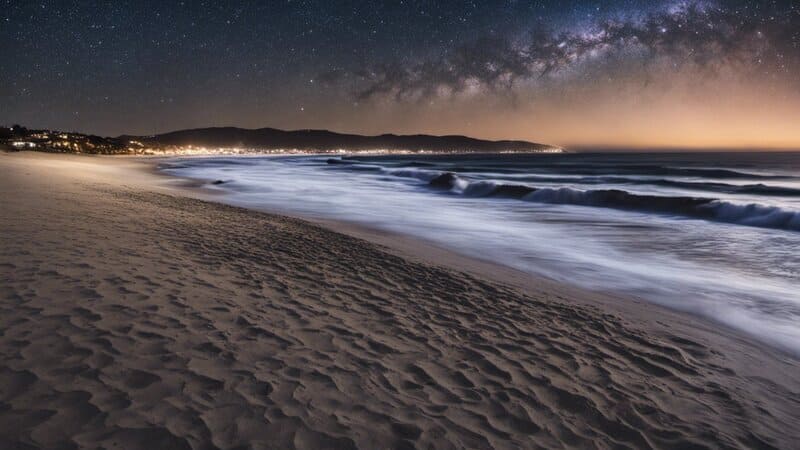
A short drive from downtown San Diego, Ocean Beach offers more than just waves and sand. By day, relish in the beach town’s laid-back atmosphere, explore local shops, and enjoy the ocean breeze. The expansive sandy shores provide ample space for beachgoers to soak up the sun.
As the sun sets over the Pacific, Ocean Beach becomes a haven for stargazers. Its coastal location minimizes urban light pollution, providing a canvas for celestial wonders to shine. The sound of ocean waves and the sight of stars combine to create a truly magical stargazing experience.
Whether you’re an astronomy enthusiast or a casual observer, Ocean Beach offers an inviting space to enjoy the cosmic display. Bring a blanket, a telescope, or simply lie back and let the stars capture your imagination. As you gaze into the night sky, you’ll find a serene connection between the vastness of the universe and the calming rhythm of the ocean.
Palomar Observatory

Situated a two-hour drive from San Diego, Palomar Observatory is a renowned center for astronomical research and exploration. During the day, marvel at the observatory’s iconic dome and architecture. The observatory houses one of the world’s largest telescopes, the 200-inch Hale Telescope, which has been instrumental in advancing our understanding of the cosmos.
As darkness falls, Palomar Observatory becomes an unparalleled stargazing destination. The observatory’s remote location and elevation ensure minimal light pollution, offering a pristine environment for cosmic observation. The giant Hale Telescope provides an unparalleled opportunity to witness celestial objects in intricate detail.
If you’re eager to learn and explore further, the observatory often hosts public events and guided tours. These events provide insights into the observatory’s history, research, and the wonders of the night sky.
Sunset Cliffs Natural Park
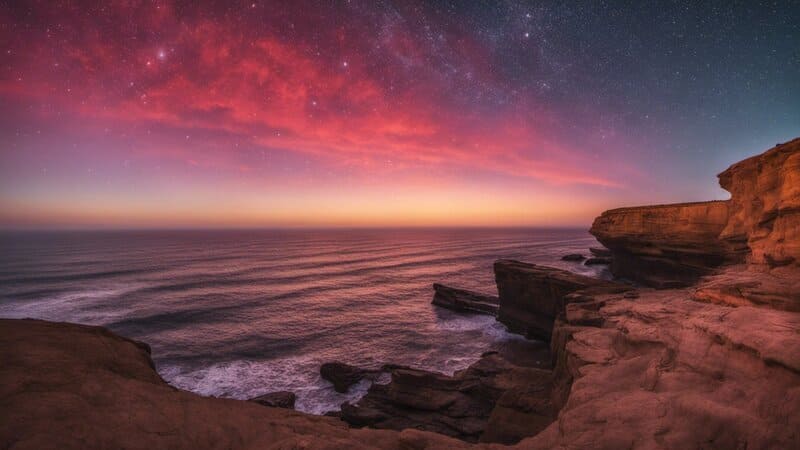
Nestled along the ocean in Point Loma, Sunset Cliffs Natural Park offers breathtaking views of the night sky against the backdrop of the Pacific coastline. By day, explore the rugged cliffs, natural arches, and tide pools that characterize this stunning coastal park. Enjoy the tranquil ambiance and the mesmerizing sight of waves crashing against the rocks.
As the sun dips below the horizon, Sunset Cliffs Natural Park transforms into a prime stargazing destination. The park’s coastal location minimizes light pollution, providing an unobstructed view of stars, planets, and the Milky Way. The rhythmic sound of the ocean enhances the cosmic experience, creating a soothing harmony between the natural world and the celestial realm.
Tierra Del Sol
Located just an hour’s drive from San Diego, Tierra Del Sol is a hidden gem in southern California for stargazing enthusiasts. During the day, explore the rugged beauty of the desert landscape and the unique flora that thrives in this arid environment. The remote location offers tranquility and a sense of escape from urban life.
As night falls, Tierra Del Sol unveils its celestial wonders. The absence of city lights results in a dark sky that’s perfect for observing stars, planets, and distant galaxies. The remote nature of this location enhances the stargazing experience, allowing you to immerse yourself in the cosmic canvas above.
Tierra Del Sol is an excellent spot for both amateur astronomers and casual stargazers. Its remoteness minimizes light pollution, and its elevation adds to the clarity of the night sky. Set up your telescope or simply lie back to enjoy the unobstructed view of the stars. The serene atmosphere and remote beauty make Tierra Del Sol a destination that promises not just a stargazing adventure, but a connection to the universe itself.
Torrey Pines State Natural Reserve
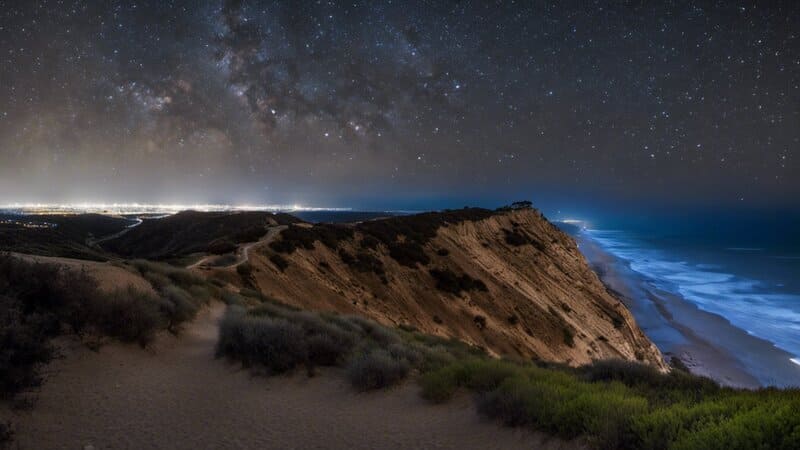
Just north of La Jolla, Torrey Pines State Natural Reserve offers stunning coastal views and diverse ecosystems during the day. Explore hiking trails that wind through coastal bluffs, revealing breathtaking views of the Pacific Ocean. Experience the unique blend of coastal chaparral, rare Torrey Pine trees, and coastal wildlife.
As the sun sets, Torrey Pines State Natural Reserve unveils its stargazing allure. The reserve’s coastal location minimizes light pollution, allowing stars and planets to shine brightly against the backdrop of the ocean. The soothing sound of the waves adds to the tranquility of the stargazing experience.
Windansea Beach – La Jolla
Discover the magic of stargazing by the ocean at Windansea Beach in La Jolla. By day, bask in the coastal charm of this picturesque beach, known for its rugged rock formations and world-class surf. Enjoy the soothing sounds of the waves and the sun’s warm embrace as you explore the sandy shores.
As the sun dips below the horizon, Windansea Beach takes on a new aura of enchantment. The absence of city lights creates a canvas for stars and planets to shine brightly against the dark sky. The rhythmic sounds of the waves provide a serene backdrop to your cosmic exploration.
Bring a blanket and settle in for a night of stargazing on the beach.
These diverse stargazing locations in San Diego offer a tapestry of experiences that unite the natural beauty of the region with the cosmic wonders of the night sky. Whether you’re drawn to desert landscapes, coastal vistas, or mountain peaks, each spot invites you to escape into the universe above and create lasting memories under the stars.
San Diego Stargazing Events and Organizations
San Diego Astronomy Association
The San Diego Astronomy Association (SDAA) is a great resource for you. They organize events throughout the year, like star parties and special events at their Tierra Del Sol Observatory.
Attending these gatherings not only gives you a chance to meet fellow stargazers but also learn from experienced members. You can find more information on their website, including an event calendar to help you plan ahead.
Julian Starfest
Located in the town of Julian, an officially recognized International Dark Sky Community, Julian StarFest is an amateur astronomer event you don’t want to miss.
It is held annually, usually in August, at the Menghini Winery.
This event offers a chance to enjoy dark skies, learn from experts through workshops, and meet like-minded stargazers. Plus, you’ll be surrounded by Julian’s charming apple orchards and wineries.
Stars in the Park
Balboa Park is not just a popular daytime attraction but also a great spot for stargazing. The SDAA hosts a monthly event called “Stars in the Park,” which typically follows “The Sky Tonight” planetarium show at the Fleet Science Center. Make sure you attend both events for a complete celestial experience.
Planetarium Show
Visiting the Fleet Science Center, located in Balboa Park, is a fantastic way to explore the wonders of our universe. Their “The Sky Tonight” planetarium show takes you on a guided tour of the cosmos, showcasing constellations, planets, and other celestial phenomena. Remember to check their website for schedule and ticket information.
- San Diego Astronomy Association (SDAA): Organizes star parties and events throughout the year.
- Julian Starfest: Annual amateur astronomer event in the International Dark Sky Community of Julian.
- Stars in the Park: Monthly stargazing event organized by SDAA in Balboa Park, following “The Sky Tonight” planetarium show.
- Planetarium Show (“The Sky Tonight”): A guided tour of the cosmos at the Fleet Science Center in Balboa Park.
Observatories in San Diego
Palomar Observatory
Located on Palomar Mountain, the Palomar Observatory is home to the impressive 200-inch Hale Telescope. This giant telescope allows you to explore the night sky in incredible detail.
When visiting, make sure to:
- Plan ahead and check the observatory’s schedule for public events.
- Bring warm clothes as the weather can be unpredictable.
- Leave any pets at home for their safety and the safety of the observatory’s delicate equipment.
Imagine looking deep into space with one of the world’s most powerful telescopes, all while being surrounded by the peaceful serenity of the mountain.
Mount Laguna Observatory
Nestled in the Cleveland National Forest at an altitude of 6,100 feet, the Mount Laguna Observatory is another excellent spot for stargazing in San Diego. It is well protected from the urban lighting of the city, and with clear nights and excellent visibility, it’s a must-visit location for astronomy enthusiasts.
When visiting Mount Laguna, remember to:
- Respect natural surroundings and wildlife
- Dress for cooler temperatures due to the higher elevation
- Follow designated paths to minimize environmental impact
Just think of how amazing it will be to stargaze in the peaceful, natural setting of Mount Laguna Observatory.
Palomar College Planetarium
For a more family-oriented experience, explore the cosmos at the Palomar College Planetarium. This accessible location in San Marcos offers exciting events and shows for budding astronomers of all ages.
Here are some tips for your visit:
- Check their website for scheduled events, like meteor shower viewings
- Arrive early to secure parking and find your seat in the planetarium
- Encourage your kids to ask questions and get excited about astronomy
By giving your family a chance to learn about the stars in an engaging, interactive environment, you’ll inspire a lifelong appreciation for the wonder of the universe.
Understanding Stargazing
Stargazing is a fascinating activity that allows you and other astronomy enthusiasts to observe and appreciate the beauty of the night sky. When gazing at the stars, you can witness a wide range of celestial objects and phenomena, such as planets, constellations, meteor showers, and even the bright band of the Milky Way. Plus, with a telescope, you can magnify these amazing sights in greater detail!
San Diego is an excellent location for stargazing as it offers a variety of spots where you can escape city lights and find clear, dark skies. Darker skies are important because they help to reduce light pollution, which makes it easier for both amateur stargazers and professional astronomers to observe celestial objects more clearly.
Here are some useful tips to make the most of your stargazing experience:
- Choose the right location: Find a spot far away from city lights, as light pollution reduces the visibility of stars and other astronomical events.
- Check the weather: Clear skies are essential for stargazing, so be sure to monitor weather forecasts to ensure perfect viewing conditions.
- Learn the night sky: Familiarize yourself with the constellations and major celestial objects so that you can easily locate them in the sky.
- Use the right equipment: A telescope or binoculars can enhance your stargazing experience by allowing you to see distant objects in more detail.
- Take your time: Give your eyes time to adjust to the darkness, and allow yourself to relax and fully appreciate the wonders of the universe.
Here’s a list of essential stargazing equipment to consider:
- A star chart or stargazing app to help identify celestial objects.
- A red flashlight to help you see in the dark without ruining your night vision.
- A telescope or binoculars for magnified observing of planets and other celestial objects.
- A comfortable chair or blanket to sit back and enjoy the view.
- Warm clothing or blankets to stay cozy during cool nights.
By following these tips and choosing a great location away from light pollution, you’ll be well on your way to enjoying the dazzling display of stars, planets, and other celestial wonders the night sky has to offer. Happy stargazing!
Best Time for Stargazing in San Diego
The ideal time to explore the dazzling night sky in San Diego is during the summer months, specifically from June to August. This is when the skies are at their clearest and most suitable for stargazing.
During this time, you can enjoy celestial events like meteor showers. The Perseids meteor shower, for instance, peaks around mid-August and offers an awe-inspiring spectacle.
To increase your chances of seeing these celestial wonders, try the following tips:
- Head away from city lights for the best experience, as light pollution can severely limit your view of the stars.
- Plan your stargazing around the moon’s phases, with new moon nights providing the darkest sky for optimal viewing.
- Be patient and give your eyes about 20-30 minutes to adjust to the darkness in order to fully appreciate the celestial beauty.
Here’s a list of some popular meteor showers to look for during the summer months in San Diego:
- Delta Aquariids – Late July
- Perseids – Mid-August
- Southern Delta Aquariids – Early August
Imagine stretching out under the vast San Diego sky and seeing countless stars twinkling above while meteors streak across the sky.
With a little preparation and the right timing, the summer months in San Diego offer an unforgettable stargazing experience for everyone.
Free Google Map of The Best San Diego Stargazing
Here is your free Google Map of the best stargazing San Diego has to offer.
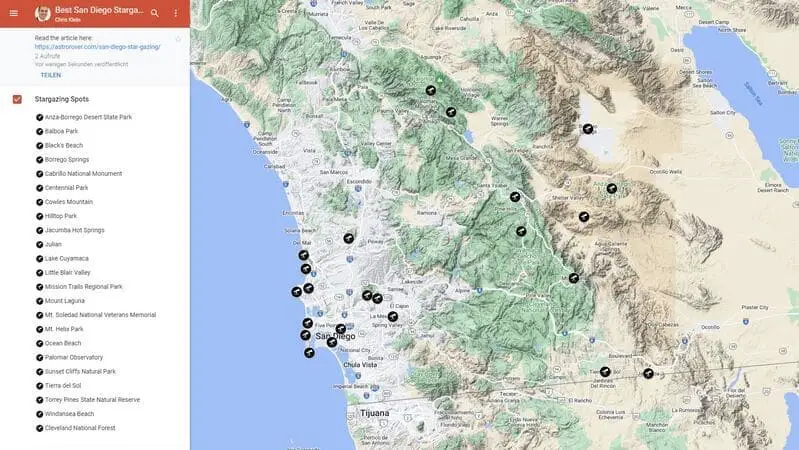
Frequently Asked Questions
What are the top stargazing locations in San Diego?
The top stargazing locations in San Diego include Ocean Beach and some other nearby beaches. Due to the city’s coastal location, these spots offer a better view of the night sky than more urban areas.
Are there any stargazing tours available in the area?
Yes, there are stargazing tours available in the San Diego area. These guided outings can take you to optimal viewing spots and may even include telescopes and expert guidance to enhance your experience.
Is Mount Laguna a good spot for star gazing?
Mount Laguna is indeed a great spot for stargazing. Home to the Mount Laguna Observatory, the higher elevation and clear skies make it an ideal location to observe the stars.
What are the best stargazing spots in Julian?
Julian is a great stargazing destination, being recognized as a dark-sky community. One top spot is the Menghini Winery, where the annual Julian StarFest takes place, celebrating amateur astronomy.
How is the stargazing experience at Anza-Borrego?
Anza-Borrego Desert State Park provides a stunning stargazing experience away from city lights. With its vast open spaces, dark skies, and minimal light pollution, it’s a fantastic location for observing the stars.
Summary: Stargazing San Diego
Thank you for reading my article on San Diego Star Gazing. San Diego offers some excellent spots for stargazing, with its diverse landscapes and locations away from city lights providing perfect conditions to observe the night sky. Some popular spots for stargazing include Cowles Mountain, Mount Laguna, Anza-Borrego Desert State Park, Borrego Springs, and Julian.
Cowles Mountain, the highest point in San Diego, offers a great panoramic view and reduced light pollution. A short hike is required to reach the top, but the sight of the stars makes it worth the effort. Mount Laguna, just under an hour outside of San Diego, has a 4,000-foot elevation, crisp air, and no city lights – ideal for a night under the stars. During daylight hours, you can explore the nearby trails to make a day out of your trip.
Anza-Borrego Desert State Park, Borrego Springs, and Julian are certified International Dark Sky Places, providing some of the best stargazing experiences in San Diego County. The Julian Starfest takes place at Menghini Winery, making for a memorable event for astronomy enthusiasts.
To make the most of your stargazing experience in San Diego:
- Choose one of the recommended locations with minimal light pollution
- Plan your trip around meteor showers or celestial events, like the Perseid meteor shower
- Avoid full moon nights, as the moonlight can make it difficult to see the stars
- Bring warm clothes, a blanket, and some snacks for a cozy night under the stars
Now, grab your telescope or binoculars, venture out, and enjoy the mesmerizing beauty of the night sky in San Diego.
Happy Stargazing!
Additional articles you may enjoy about California in my USA Guides series:
- Best Stargazing in California
- Best Stargazing in Orange County
- Julian Stargazing (home of the annual Starfest)
- When can you see the Milky Way in California?
- What is the brightest star in California?
- Can you see the Milky Way from Los Angeles?
- Templin Highway Stargazing Area (just north of Los Angeles)
- Lake Tahoe Stargazing




